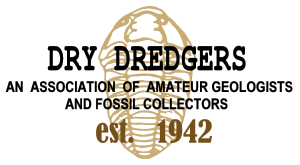Two previous Dry Dredgers blogs (2/23/16 and 6/30/16) summarize field trips that Tom Bantel and I took to the Silurian Brassfield Limestone in Ripley County, Indiana. On those previous visits, we collected samples for stratigraphy studies being done by Dr. Mark Kleffner (Ohio State University at Lima). Tom and I recently returned to obtain additional samples for his research.
In our previous collecting, samples were collected at half-meter intervals through the approximately 10 vertical feet of Brassfield exposure in a commercial rock quarry in Ripley County. Dr. Kleffner used those samples for isotope ratio (carbon-13/carbon-12) mass spectrometry to help age the rocks, by comparing the “isotopic signature” (isotopic fingerprint) against known fluctuations in the Silurian.
To obtain a more detailed read on the isotopic signature, he asked if we could collect additional samples at more frequent intervals. And of course we said, “Yes.”
The process started by getting a GPS reading on the specific spot we chose. We cleared away the scree at the bottom of the wall to expose the base. After that, we marked and numerically labeled 10-cm intervals on the vertical quarry wall.

Don marking the 10-cm intervals. Note the sparkly yellow-orange color that gives the layer its “Golden” name. (The quarry where we collect mines the Brassfield to crush into agricultural lime.)
Then we collected samples below the base, at the base (zero-cm interval), from each 10-cm interval above the base, and from the cap rock on top.
The desired sample size for Dr. Kleffner’s analysis is 1-2 inches thick and 1-2 inches in diameter. Because of the extensive fracturing of the face of the exposure from blasting by the quarry operations, some of the samples pulled from the wall were the correct size. However, since several of the samples were still too large, they were trimmed with a Stihl rock saw.
The top and bottom of each sample was marked. Then each sample was placed in a labeled bag, with a back-up paper label inside the bag. At present, we still have all the samples. In early October, they will be transferred to Dr. Kleffner.
We look forward to hearing the results of Dr. Kleffner’s analysis of the samples. And, of course, we’ll gladly return to the Brassfield if he needs more material for his studies.
Don Bissett

A long-time member of the Dry Dredgers, I’ve been collecting fossils ever since moving to Cincinnati in 1975 to work at P&G. I was introduced to fossil collecting by Bruce Gibson, another Dry Dredger and co-worker at P&G. Shortly after that, I met Dredger Dan Cooper. Both of them taught me a lot about the hobby. Ever since, I’ve been hooked on fossils.
My primary focus is collecting trilobites and echinoderms, though I often find myself accumulating a much wider assortment of fossils. Beyond the collecting hobby, I’ve also had the opportunity to work with professional paleontologists – extremely rewarding experiences. Some of those have been described in Dry Dredger Bulletin articles, MAPS (Mid-American Paleontology Society) articles, and technical publications. I plan to share more about collecting and professional interactions in my blog posts.Latest posts by Don Bissett (see all)
- Massie Shale Calymene - January 4, 2021
- Mississippian starfish - November 13, 2020
- Walcott-Rust Starfish - October 25, 2020
- Spathacalymene - September 20, 2020
- Penn Dixie Dig with the Experts 2018 - May 27, 2018






